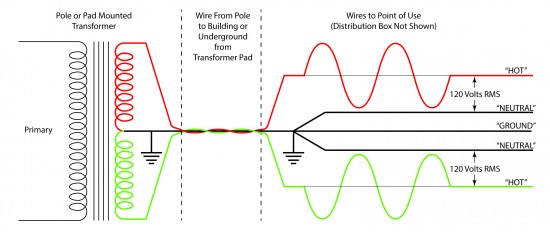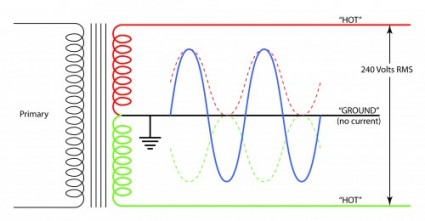Electricity is not something we give considerable attention to in our daily lives. At home or at work (or wherever) there are electrical outlets. We simply plug devices into the outlets and the devices light up, heat, rotate, vibrate, charge or do whatever they’re supposed to do. What’s behind the outlet, generally, is of little concern to us. However, how this all happens is interesting and, sometimes, important. Those of us who have done some world travel know that electricity in various countries and regions varies in voltage, but what we may not know, is that there are some major differences in the connections behind the walls that may, in some cases, be of significant consequence.
 Let’s start with the United States where electricity is available at an outlet that looks like the one shown at the right. Used in most of North America, this is a standard 120 volt outlet found in homes and offices. Most of us know that the two “slots” are the actual electrical conductors and that the other hole which is sort of a “D” shape turned on its side is the ground. Of the two slots, the wider (taller) is intended to be the “ground” while other is the “hot” side of the circuit. The “ground” slot and the “D” are both at ground potential but are connected to the distribution box by separate wires. This information is usually plenty for the casual user of electrical outlets but it is interesting what goes on behind the walls.
Let’s start with the United States where electricity is available at an outlet that looks like the one shown at the right. Used in most of North America, this is a standard 120 volt outlet found in homes and offices. Most of us know that the two “slots” are the actual electrical conductors and that the other hole which is sort of a “D” shape turned on its side is the ground. Of the two slots, the wider (taller) is intended to be the “ground” while other is the “hot” side of the circuit. The “ground” slot and the “D” are both at ground potential but are connected to the distribution box by separate wires. This information is usually plenty for the casual user of electrical outlets but it is interesting what goes on behind the walls.
The electricity starts out at the power plant. Before it reaches the distribution panel in your house, there is a transformer which reduces one phase of a three phase source from many thousands of volts down to that appropriate to power various devices to be connected. In general this is 120/240 volts in a “split phase” configuration.
Note – 120 Volt power may also be derived directly from a three phase source with each phase providing 208 Volts. In that case, wiring is totally different and will be the subject for another blog.

A transformer reduces the voltage from the primary source down to 240 volts RMS in the secondary coil. The secondary coil has a center tap which is connected to ground (ground rod, water pipe or other “solid” ground). As the diagram above shows, this configuration provides two 120 volt RMS sources. Devices operating at 120 volts RMS (outlets, lamps, appliances, etc.) are connected to one of these two sources in a somewhat arbitrary manner with 1/2 of the devices operating with alternating current that is 180 degrees out of phase with the others. These two phases are the reason for the term split phase.
In the case of devices that use large amounts of electricity (stove, heat, air conditioning, etc.) the differential between the two phases is used to provide a 240 volt RMS source as shown below.

The important thing to note here is that NEITHER of the “hot” wires is ground although devices operating from 240 volts RMS are required to have a “ground” wire connected to the earth ground for the purpose of safety! There are hybrid devices that utilize both 120 and 240 volts RMS (some stoves and air conditioners for example). These devices must have 4 wires. One connected to each side of the 240 volts RMS source, one connected to the centertap/ground of the transformer (to act as the neutral for the 120 volt RMS source(s) ) and another connected to the earth ground for safety.
The above is a convention for the United States. Other countries and areas (sometimes even areas within a single country) may derive various voltages using totally different schemes. This may make things a little tricky, especially when it comes to grounding.
– FJF –



 English
English Spanish
Spanish Chinese
Chinese Canada
Canada Mexico
Mexico United Kingdom
United Kingdom



